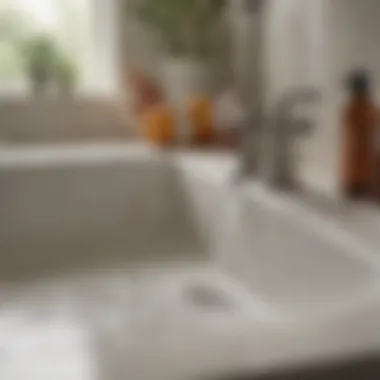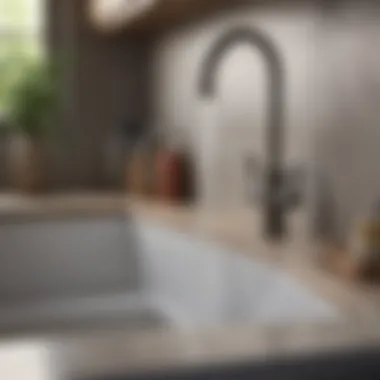Effective Home Remedies for Clogged Kitchen Sinks


Intro
A clogged kitchen sink can be more than a minor inconvenience; it can fundamentally disrupt your daily routines. When faced with this common household problem, many homeowners often feel helpless or unsure about how to tackle it effectively. Understanding the underlying causes of clogs can illuminate various practical approaches to remedy the issue. From routine maintenance to applying home remedies, this article will guide you through effective strategies to restore your sink's flow smoothly.
In this exploration of home remedies, we will delve into natural solutions, everyday household products, and preventative measures. The aim is to equip readers with informed methods to resolve clogs and maintain their plumbing systems proactively. By using insights backed by common household wisdom, you will be able to address and manage issues that might arise and ensure your kitchen remains functional for your needs.
It is crucial to recognize that prevention is often more manageable than remedy. Thus, we will also focus on preventive strategies that safeguard against future blockages. As we proceed, expect to uncover valuable tips and techniques that are both accessible and effective, ultimately helping you save time and resources.
Understanding the Clogged Kitchen Sink
A clogged kitchen sink is more than just an annoyance; it can significantly disrupt daily activities. It is essential to understand the various aspects of this issue to effectively tackle it. This section delves into the causes and identification of clogs, providing a framework for the subsequent remedies.
Common Causes of Kitchen Sink Clogs
Understanding the common causes of kitchen sink clogs is vital. These clogs often result from a buildup of debris, grease, and food particles. Here are the primary culprits:
- Food Scraps: Unintentionally washing small food remnants into the drain can accumulate over time, leading to blockages.
- Grease Buildup: When grease is poured down the sink, it cools and hardens, creating a sticky trap for other materials.
- Foreign Objects: Occasionally, non-food items may accidentally fall into the sink and clog the drain.
- Hair: In homes where sinks are used for washing hair, strands can easily gather and obstruct drainage.
- Soap Scum: Accumulation of soap can also adhere to pipes, gradually narrowing the passage of water.
Recognizing these factors can help homeowners adopt better practices to minimize risk.
Identifying the Signs of a Clog
Identifying signs of a clog early can prevent more severe issues later. Common indicators include:
- Slow Drainage: Water taking longer than usual to drain is often the first sign of trouble. It indicates that something is obstructing the flow.
- Gurgling Sounds: Unusual sounds when draining water can signal air pockets trapped in the plumbing, a reaction to a clog.
- Foul Odors: Bad smells emanating from the sink may suggest decaying food or stagnant water.
- Water Backups: If water starts coming back up the drain when using the sink, it’s a clear indicator of a blockage.
Being aware of these signs allows for prompt action, reducing the chances of a complete blockage and the need for more drastic measures.
Initial Assessment
The initial assessment is a crucial step in addressing a clogged kitchen sink. Often, homeowners rush to remedies without fully understanding the root cause of the obstruction. This can lead to ineffective treatments and wasted time. By conducting a thorough assessment, you gain insight into specific issues, enabling you to apply the correct solutions. The importance lies in identifying whether the problem is localized in the sink or if it extends further into the plumbing, which could require different approaches.
A systematic evaluation not only addresses the immediate symptom of a clog but also helps in recognizing potential underlying problems that can lead to future clogs. This proactive stance saves effort in the long run, as adequately diagnosing the issue could prevent recurrent blockages. In cases where DIY efforts do not resolve the problem, you’ll be better prepared to communicate with a professional about the specifics of the issue encountered.
Check the Garbage Disposal
The garbage disposal often plays a key role in the overall drainage system of a kitchen sink. If a clog occurs, it is essential to check this device first. Many clogs stem from food debris that has collected within the disposal or from objects that have accidentally been sent through. Start by switching off the power at the circuit breaker to ensure safety while inspecting.
Once the power is off, look inside the disposal with a flashlight. Remove any visible objects, such as utensils or excessive food particles. If the disposal is jammed, you may need to insert an Allen wrench into the bottom of the unit to manually spin the blades and break the blockage. Running water through the system after clearing it can help to flush out remaining debris. Additionally, always ensure that the disposal is receiving power and functioning properly. When in doubt, consult the manufacturer's instructions for troubleshooting.
Inspect the Sink Drain
Next, inspecting the sink drain itself can reveal much about the clog's location and severity. Often, food particles, grease, and soap residue are the common culprits collecting at this point. First, remove the sink strainer or the stopper and check for visible blockages. A good practice is to use a flashlight to ensure no debris is obstructing the drain opening.
If you see buildup, consider using a combination of boiling water and a gentle scrub to clean around this area. Inspect any visible plumbing beneath the sink, looking for any leaks or excessively wet spots that may indicate a blockage further along the pipe.
Tip: Keep a small bucket handy to catch any water or debris that may escape during your inspection. Routine checks can help identify slow-draining issues before they escalate into a full blockage.
By carefully evaluating both the garbage disposal and the sink drain, you lay the groundwork for effective home remedies that can restore flow and function to your kitchen sink.
Basic Home Remedies


Home remedies play a crucial role in addressing a clogged kitchen sink. They offer cost-effective solutions using readily available ingredients, providing alternatives to expensive plumbing services. These remedies often employ natural elements that are safer for both the environment and the plumbing system compared to chemical treatments. Moreover, many people prefer using simple household items rather than commercial products, which can create additional waste or pose health risks.
By understanding and utilizing basic home remedies, homeowners can save time and effort. These methods are not necessarily the most advanced, but they can effectively alleviate minor clogs and prevent them from escalating into more significant plumbing issues. Employing such remedies promotes a proactive approach to home maintenance, ensuring that the kitchen remains functional and free from interruptions.
Boiling Water Method
The boiling water method is a simple yet powerful solution for many clogs. Its effectiveness comes from the high temperature of the water, which can dissolve grease and soap buildup in pipes. To use this method, simply heat water in a kettle until it reaches a rolling boil. Once it is ready, carefully pour the boiling water directly down the drain in two or three stages, allowing a moment in between for the water to work on the blockage.
Benefits of using boiling water include:
- Cost-effectiveness: Just tap water and heating it. No additional products needed.
- Environmentally friendly: Unlike harsh chemicals, it does not harm fish or local ecosystems.
- Simplicity: This method requires no advanced tools or techniques, making it accessible for everyone.
It is important, however, to consider the material of your plumbing. While most metal pipes can handle boiling water, PVC pipes may warp under excessive heat.
Baking Soda and Vinegar
Combining baking soda and vinegar has been a popular remedy for clogs for ages. It harnesses the potent reaction between baking soda, a base, and vinegar, an acid, to create carbon dioxide bubbles that can help to break down debris in the pipes.
To implement this method, follow these simple steps:
- Pour half a cup of baking soda into the clogged drain.
- Follow it with half a cup of vinegar. The mixture may fizz and bubble.
- Wait for at least 30 minutes, allowing the reaction to work on dislodging the clog.
- Finally, flush the drain with hot water to rinse any remaining debris.
Why this method is effective:
- Natural Ingredients: Both components are common household items, making them easy to come by.
- Effective for Organic Matter: This remedy is particularly good for clogs caused by hair, food particles, or soap scum.
- Cleans the Drain: In addition to clearing clogs, it leaves the drain cleaner and fresher smelling.
Salt and Baking Soda
The combination of salt and baking soda serves as a formidable duo for unclogging drains. This mix works especially well for dissolving grease and food particles. To carry out this remedy, you will need:
- Mix a quarter cup of salt with a quarter cup of baking soda.
- Pour this mixture down the drain.
- Follow it with a pot of boiling water.
Benefits of this technique include:
- Grease Breakdown: Salt helps to further dissolve any greasy buildup.
- Abrasive Action: The baking soda provides gentle abrasiveness that can help scrub away stubborn clogs.
- Long-term Results: This mixture can help maintain clear drains and thus enhance the overall performance of the kitchen sink.
Utilizing these basic home remedies not only resolves immediate plumbing concerns but also encourages mindful home care practices and sustainability.
Using Natural Ingredients
Natural ingredients are valuable alternatives when addressing a clogged kitchen sink. They offer a non-toxic approach that is effective and safe for both the plumbing system and the environment. Using these ingredients can reduce reliance on harsh chemicals, which can damage pipes and pose risks to health. Furthermore, many household items serve dual purposes, making them convenient solutions readily available in most kitchens.
Natural remedies often present affordability as another advantage. They require no special equipment or expensive products. With minimal effort, homeowners can employ these techniques to maintain their sinks. Now, let's explore some effective natural solutions.
Lemon Juice
Lemon juice is a versatile ingredient known for its cleaning properties. Due to its acidity, it can help break down grease and food particles clogging the drain. Using lemon juice is simple; just squeeze the juice of one or two lemons into the sink and follow it with hot water. This can effectively clear minor clogs, and its fresh scent can neutralize odors.
Moreover, lemon juice can be combined with other natural ingredients for an increased effect. For example, mixing lemon juice with baking soda creates a bubbling reaction that can help dislodge stubborn buildups. This method is not only effective but contributes to a pleasant fresh smell in the kitchen.
Dish Soap and Hot Water
Dish soap is commonly found in most kitchens, making it an accessible choice for unclogging sinks. It is particularly effective on grease-related clogs. When mixed with hot water, dish soap can break down oily substances in the pipes. To use this method, pour a generous amount of dish soap down the drain, then follow with boiling water.


This combination helps to lubricate the pipes, allowing the grease to slide down more easily. It is advisable to repeat this a couple of times for optimal results, especially in cases of severe clogs. The gentle cleaning properties of dish soap make it a preferable alternative for cautious homeowners.
Cream of Tartar
Cream of tartar is another household ingredient that can assist in unclogging sinks. While not commonly recognized for plumbing solutions, it can significantly aid in cleaning due to its acidic properties. To use cream of tartar, mix it with boiling water and pour it into the drain. Let it sit for about 30 minutes before flushing it with hot water.
This method not only helps in dislodging buildups but also promotes a cleaner environment within your plumbing system. It is often underutilized in household remedy discussions, yet it can be very effective and safe to use.
"Using natural ingredients for unclogging can be both practical and eco-friendly."
Tools for Managing Clogs
Addressing a clogged kitchen sink often requires specific tools to restore flow efficiently. Understanding these tools is essential not only for the immediate relief of a blockage but also for maintaining proper kitchen hygiene and plumbing integrity. Each tool has distinct applications and benefits, making them valuable assets in a household.
Plunger Usage
The plunger is a basic yet highly effective tool for unclogging sinks. It works by creating suction and pressure to dislodge debris blocking the drain.
To use a plunger effectively, one should first ensure there is enough water in the sink to cover the rubber portion of the plunger. Firmly placing the plunger over the drain hole, push down and pull up rapidly for several repetitions.
Considerations for using a plunger include:
- Assessing the Type of Clog: This tool is most effective for softer blockages, such as food particles and grease.
- Cleanliness: Always clean the plunger after use to prevent cross-contamination.
- Pressure Control: Avoid excessive force, which can damage pipes or worsen the blockage.
Drain Snake Technique
A drain snake, or auger, is another powerful tool for tackling stubborn clogs. This device consists of a flexible, coiled metal wire that can reach deep into pipes.
To use a drain snake:
- Insert the end into the drain.
- Rotate the handle to extend the snake into the pipes.
- Feel for resistance, which indicates the clog.
- Rotate and push to break apart the blockage.
Keep in mind:
- Types: There are manual and powered versions, with powered ones being more adept for severe blockages.
- Safety: Always wear gloves and eye protection to avoid debris splashes.
Wet/Dry Vacuum
A wet/dry vacuum can be an effective tool for unclogging kitchen sinks. This tool is capable of removing liquids and solids, making it versatile for various types of clogs.
To utilize a wet/dry vacuum:
- Set the vacuum to liquid mode (if applicable).
- Create a seal around the drain with the nozzle.
- Turn on the vacuum to pull out the blockage and standing water.
Benefits include:
- Versatility: Ideal for sucking out both liquid and solid debris.
- Effectiveness: Can handle significant amounts of waste without causing additional mess.
Using the right tools can significantly ease the process of managing clogged kitchen sinks. Each tool serves a unique purpose, ensuring that homeowners can tackle various types of clogs efficiently.
Preventative Measures


Preventative measures are essential in maintaining the functionality of your kitchen sink. They can save you from costly repairs and inconvenient clogs in the future. By adopting certain habits and practices, you can significantly reduce the chances of encountering a clogged sink.
Routine Maintenance
Performing routine maintenance on your kitchen sink is vital. Regularly check for signs of wear on various components, such as the faucet and sink strainer. Drain screens are particularly effective at catching food debris and small particles. Make a habit of cleaning these screens frequently to prevent build-up.
You may also want to run hot water through your sink daily. This simple action helps dissolve grease and other residues that can accumulate over time. Consider setting reminders to schedule these tasks weekly or monthly, ensuring they do not fall by the wayside.
Proper Disposal Practices
Being conscious of what goes down your kitchen sink can greatly influence the longevity of its drainage system. Certain substances, including oils, fats, and fibrous foods like celery or potato peels, should never be disposed of through the sink. These materials can solidify or create blockages.
Instead, use the garbage disposal properly by letting cold water run while it’s active. This practice helps flush remaining debris through the system. Always remind your household members about these disposal practices to keep everyone on the same page.
Regular Cleaning Protocols
Incorporating regular cleaning protocols into your routine also contributes to preventative measures. Use a natural cleaner, such as a mixture of baking soda and vinegar, to periodically clean your sink. Not only does this eliminate any unpleasant odor, but it can also break down minor build-up that could eventually lead to more significant issues.
Another step to consider is cleaning the inlet pipes under your sink. Over time, these pipes can gather residue. Unscrew them and rinse them out with hot water when needed. Aim for a thorough clean at least once every few months to maintain the flow of your sink.
By implementing these preventative measures, you can minimize the risk of clogs and maintain better overall plumbing health in your kitchen.
When to Seek Professional Help
A clogged kitchen sink, while often manageable with home remedies, can present persistent challenges that require the expertise of a professional plumber. Evaluating when to call for expert help is crucial, as it can save you from further complications and expense. The importance of addressing such plumbing issues cannot be understated, especially when simple solutions do not yield results. Proactive measures can prevent minor issues from escalating into major repairs.
Identifying Recurring Issues
Recognizing patterns in plumbing problems is essential. If you find that your kitchen sink clogs multiple times in a short period, this may indicate an underlying issue that is not merely a local blockage. Here are some indicators that suggest you should consult a professional:
- Frequent Backups: If the sink backs up several times a month, it may be time for professional assessment.
- Slow Drainage: A consistently slow sink can suggest deeper clogs.
- Unusual Sounds: Gurgling noises from the drain can indicate problems within the plumbing system.
- Water Quality: If you notice discolored water or a foul smell, it could point to a more serious issue.
Ignoring these signs can lead to more extensive damage, including potential flooding, which can be costly to rectify. In such cases, a qualified plumber can perform a thorough inspection and diagnose problems like tree root intrusion or pipe breaks.
Understanding Sewer Line Problems
Sewer line issues are among the more complex plumbing problems that can affect kitchen sinks. If the issue extends beyond just the sink and involves the overall plumbing system, a certified professional must evaluate the situation. Here are some signs that sewer line problems may be at play:
- Multiple Drains Are Affected: If other drains in your home are also slow or backed up, the issue may reside in the sewer line.
- Sewage Odors: Foul smells around the house can indicate sewer breaks or blockages.
- Lush Patches of Grass: Unusually green grass in your yard can signal a leaking sewer line beneath.
- Water Pooling: Standing water in the yard can indicate a serious sewer line issue.
"Addressing sewer line issues promptly is key to preventing extensive damage to your property and can lead to significant restoration costs."
In summary, knowing when to seek professional help is a skill that can spare homeowners many headaches. If you begin to notice persistent issues or symptoms that indicate malfunction not solvable by home remedies, it’s time to involve a professional to ensure the safety and integrity of your plumbing system.
End
Recap of Effective Remedies
The remedies discussed throughout this article all offer unique advantages. Techniques such as using boiling water, vinegar and baking soda, as well as natural ingredients like lemon juice, all serve as accessible methods to tackle minor clogs. For individuals facing more significant issues, tools like a plunger or drain snake prove essential. Effective management combines both immediate solutions and a consistent maintenance routine.
- Boiling Water: Often the simplest approach that may dissolve grease or soap buildup.
- Baking Soda and Vinegar: A natural and chemical-free solution that can help clear small blockages.
- Lemon Juice: Not only does it aid in unclogging but also deodorizes the drain.
- Drain Snake Technique: Useful for deeper clogs that regular methods cannot clear.
Future Considerations
As homeowners strive to keep their kitchen sinks clear, they should consider implementing regular inspections and cleaning methods. It is also important to adopt proper disposal practices to minimize the risk of future clogs. Consulting with plumbing experts at times can provide deeper insights into potential systemic issues.
Maintaining awareness of how daily practices impact plumbing can lead to a more functional kitchen environment. Implementing these strategies will not just ensure a free-flowing sink, but can also enhance the overall health of the plumbing system.
Engaging with resources such as Wikipedia or Britannica can offer additional insights into common plumbing issues. For community discussions, platforms like Reddit may provide invaluable personal experiences and advice.
"An ounce of prevention is worth a pound of cure." - Benjamin Franklin
Applying the practices outlined can help homeowners navigate kitchen plumbing effectively.







